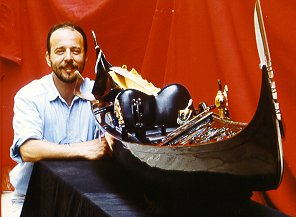Ok not a real Gondola but the best thing after that. Alberto Penzo in his wonderful shop at S Polo 2681 sells amazing Venetians boats reproductions, not the tacky plastic ones you see walking around, we are talking about real gondolas!The Venetian lagoon has a well-established ship-building tradition. Couple that with an intense passion for boat making and you have a stunning collection of gondola model boat kits constantly in production and on sale.
Gilberto Penzo, born in Chioggia in 1954 from a family of craftsmen and shipbuilders, lives in Venice where for many years he has been conducting a vast research, gathering and organizing information about traditional Venetian boats.
Explanations and direct examples of the last remaining gondola builders (squerariòi), surveys of ancient templates and pattern s, and - in ideal cases - the direct measurement of intact boats, are the sources which allow the author to reconstruct their forms and the construction methods used. These have given rise to a series of books, construction plans, models for museums and private collections, restorations ans reconstructions of boats.With a group of friends who share the same interest, he founded the association Arzanà in 1992 which specializes in the study and conservation of historical Venetian boats.
s, and - in ideal cases - the direct measurement of intact boats, are the sources which allow the author to reconstruct their forms and the construction methods used. These have given rise to a series of books, construction plans, models for museums and private collections, restorations ans reconstructions of boats.With a group of friends who share the same interest, he founded the association Arzanà in 1992 which specializes in the study and conservation of historical Venetian boats.
If you are not coming to Venice soon you can get them here
 The lagoon city has a long and glorious culinary tradition based on fresh seafood. A writhing, glistening variety of sea creatures swims from the stalls of the Rialto and Chioggia markets into local kitchens. Going with the flow of la cucina veneta requires a certain spirit of open minded experimentation. Not everybody has eaten granseola (spider crab) before, or garusoli (sea snails) or canoce (mantis shrimps), but Venice is definitely the place to try these marine curios.
The lagoon city has a long and glorious culinary tradition based on fresh seafood. A writhing, glistening variety of sea creatures swims from the stalls of the Rialto and Chioggia markets into local kitchens. Going with the flow of la cucina veneta requires a certain spirit of open minded experimentation. Not everybody has eaten granseola (spider crab) before, or garusoli (sea snails) or canoce (mantis shrimps), but Venice is definitely the place to try these marine curios.
 s, and - in ideal cases - the direct measurement of intact boats, are the sources which allow the author to reconstruct their forms and the construction methods used. These have given rise to a series of books, construction plans, models for museums and private collections, restorations ans reconstructions of boats.With a group of friends who share the same interest, he founded the association Arzanà in 1992 which specializes in the study and conservation of historical Venetian boats.
s, and - in ideal cases - the direct measurement of intact boats, are the sources which allow the author to reconstruct their forms and the construction methods used. These have given rise to a series of books, construction plans, models for museums and private collections, restorations ans reconstructions of boats.With a group of friends who share the same interest, he founded the association Arzanà in 1992 which specializes in the study and conservation of historical Venetian boats.

